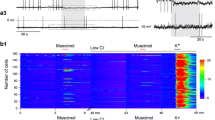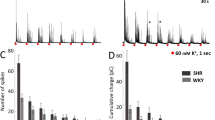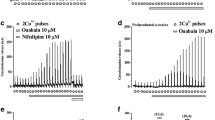Abstract
The purpose of this study was to determine whether bromocriptine affects the catecholamines (CA) secretion evoked in isolated perfused rat adrenal glands, by cholinergic stimulation, membrane depolarization and calcium mobilization, and to establish the mechanism of its action. The perfusion of bromocriptine (1~10 μM) into an adrenal vein, for 60 min, produced relatively dose-dependent inhibition in the secretion of catecholamines (CA) evoked by acetylcholine (ACh, 5.32 mM), DMPP (100 μM for 2 min), McN-A-343 (100 μM for 2 min), cyclopiazonic acid (CPA, 10 μM for 4 min) and Bay-K-8644 (10 μM for 4 min). High K+ (56 mM)-evoked CA release was also inhibited, although not in a dose-dependent fashion. Also, in the presence of apomorphine (100 μM), which is also known to be a selective D2-agonist, the CA secretory responses evoked by ACh, high potassium, DMPP, McN-A-343, Bay-K-8644 and cyclopiazonic acid were also significantly depressed. However, in adrenal glands preloaded with bromocriptine (3 μM) in the presence of metoclopramide (15 μM), a selective D2-antagonist, the CA secretory responses evoked by ACh, high potassium, DMPP, McN-A-343, Bay-K-8644 and cyclopiazonic acid considerably recovered as compared to that of bromocriptine only. Taken together, these results suggest that bromocriptine can inhibit the CA secretion evoked by stimulation of cholinergic receptors, as well as by membrane depolarization, in the perfused rat adrenal medulla. It is thought this inhibitory effect of bromocriptine may be mediated by inhibiting the influx of extracellular calcium and the release from intracellular calcium stores, through the activation of dopaminergic D2-receptors located in the rat adrenomedullary chromaffin cells. Furthermore, these findings also suggest that the dopaminergic D2-receptors may play an important role in regulating adrenomedullary CA secretion.
Similar content being viewed by others
References
Anton, A.H., and Sayre, D.F., A study of the factors affecting the aluminum oxide trihydroxy indole procedure for the analysis of catecholamines.J. Pharmacol. Exp. Ther., 138, 360–375 (1962).
Artalejo, A.R., Ariano, M.A., Perlman, R.L., and Fox, A.P., Activation of facilitation calcium channels in chromaffin cells by D1 dopamine receptors through an AMP/protein kinase A-dependent mechanism.Nature, 348, 239–242 (1990).
Artalejo, A.R., Garcia, A.G., Montiel, C., and Sanchez-Garcia, P., A dopaminergic receptor modulates catecholamine release from the cat adrenal gland.J. Physiol., 362, 359–368 (1985).
Bigornia, L., Allen, C.N., Jan, C.R., Lyon, R.A., Titeler, M., and Schneider, A.S., D2 dopamine receptors modulate calcium channel currents and catecholamine secretion in bovine adrenal chromaffin cells.J. Pharmacol. Expt. Ther., 252(2), 586–592 (1990).
Bigornia, L., Suozzo, M., Ryan, K.A., Napp, D., and Schneider, A.S., Dopamine receptors on adrenal chromaffin cells modulate calcium uptake and catecholamine release.J. Neurochem., 51, 999–1006 (1988).
Blanco, M., Hurtado, N., Jelambi, I., Perez, G., Carrillo, M., Gomez, J., Bravo, C., Gomez, H., Collet, H., and Velasco, M., Dopaminergic influence on cardiovascular responses to exercise stress in hypertensive subjects.Am. J. Ther., 4, 31–33 (1997).
Caron, M.G., Beaulieu, M., Raymond, V., Gagne, B., Drouin, J., Lefkowitz, R.J., and Labrie, F., Dopaminergic receptors in the anterior pituitary gland.J. Biol. Chem., 253, 2244–2253 (1978).
Challiss, R.A.J., Jones, J.A., Owen, P.J., and Boarder, M.R., Changes in inositol 1,4,5-trisphosphate and inositol 1,3,4,5- tetrakisphosphate mass accumulations in cultured adrenal chromaffin cells in response to bradykinin and histamine.J. Neurochem., 56, 1083–1086 (1991).
Cheek, T.R., O’Sullivan, A.J., Moreton, R.B., Berridge, M.J., and Burgoyne, R.D., Spatial localization of the stimulus-induced rise in cytosolic Ca2+ in bovine adrenal chromaffin cells: Distinct nicotinic and muscarinic patterns.FEBS. Lett., 247, 429–434 (1989).
Collet, A.R., and Story, D.F., Is catecholamine release from the rabbit adrenal gland subject to regulation through dopamine receptors or β-adrenoceptors?Clin. Exp. Pharmacol. Physiol., 9, 436 (1982a).
Collet, A.R., and Story, D.F., Release of3H-adrenaline from an isolated intact preparation of the rabbit adrenal gland: No evidence for release modulatory α-adrenoceptors.J. Auton. Pharmacol., 2, 25–34 (1982b).
Cooper, D.M.F., Bier-Laning, C.M., Halford, M.K., Ahlijanian, M.K., and Zahniser, N.R., Dopamine acting through D2 receptors inhibits rat striatal adenylate cyclase by a GTP- dependent process.Mol. Pharmacol., 29, 113–119 (1986).
Dahmer, M.K., and Senogles, S.E., Differential inhibition of secretagogue-stimulated sodium uptake in adrenal chromaffin cells by activation of D4 and D5 dopamine receptors.J. Neurochem., 67, 1960–1964 (1996).
Damase-Michel, C., Montastruc, J.L., Geelen, G., Saint-Blanquat, G.D., and Tran, M.A., Effect of quinpirole a specific dopamine DA2 receptor agonist on the sympathoadrenal system in dogs.J. Pharmacol. Expt. Ther., 252(2), 770–777 (1990).
Damase-Michell, C., Montastruc, J.L., and Tran, M.A., Dopaminergic inhibition of catecholamine secretion from adrenal medulla is mediated by D2-like but not D1-like dopamine receptors.Clin. Expt. Pharmacol. Physiol., 26(suppl.), S67-S68 (1999).
De Vliefer, T.A., Lodder, J.C., Werkman, T.R., and Stoof, J.C., Dopamine receptor stimulation has multiple effects on ionic currents in neuroendocrine cells of the pond snailLymnaea stagnalis.(Abstr) Neuroscience Lett [Suppl]., 22, S418 (1985).
Fohr, K.J., Ahnert-Hilger, G., Stecher, B., Scott, J., and Gratzl, M., GTP and Ca2+ modulate the inositol 1,4,5-trisphosphate-dependent Ca2+ release in streptolysin O-permeabilized bovine adrenal chromaffin cells.J. Neurochem., 56, 665–670 (1991).
Forsberg, E.J., Rojas, E., and Pollard, H.P., Muscarinic receptor enhancement of nicotinic-induced catecholamine secretion may be mediated by phosphoinositide metabolism in bovine adrenal chromaffin cells.J. Biol. Chem., 261, 4915–4920 (1986).
Garcia, A.G., Sala, F., Reig, J.A., Viniegra, S., Frias, J., Fonteriz, R., and Gandia, L., Dihydropyridine Bay-K-8644 activates chromaffin cell calcium channels.Nature, 309, 69–71 (1984).
Goerger, D.E., and Riley, R.T., Interaction of cyclopiazonic acid with rat skeletal muscle sarcoplasmic reticulum vesicles. Effect on Ca2+ binding and Ca2+ permeability.Biochem. Pharmacol., 38, 3995–4003 (1989).
Gonzales, M.C., Artalejo, A.R., Montiel, C., Hervas, P.P., and Garcia, A.G., Characterization of a dopaminergic receptor that modulates adrenomedullary catecholamine release.J. Neurochem., 47, 382–388 (1986).
Huettl, P., Gerhardt, G.A., Browning, M.D., and Masserano, J.M., Effects of dopamine receptor agonists and antagonists on catecholamine release in bovine chromaffin cells.J. Pharmacol. Expt. Ther., 257(2), 567–574 (1991).
Kebabian, J. W., and Calne, D. B., Multiple receptors for dopamine.Nature, 277(5692), 93–96 (1979).
Kebabian, J. W., Augi, T., van Oene, J. C., Shigematsu, K., and Saavedra, J. M., The dopamine receptor: New perspectives.Trends. Pharmacol. Sci., 7, 96–99 (1986).
Kim, K.T., and Weathead, E.W., Cellular responses of Ca2+ from extracellular and intracellular sources are different as shown by simultaneous measurements of cytosolic Ca2+ and secretion from bovine chromaffin cells.Proc. Natl. Acad. Sci. USA., 86, 9881–9885 (1989).
Lim, D.Y., Kim, C.D., and Ahn, K.W., Influence of TMB-8 on secretion of catecholamines from the perfused rat adrenal glands.Arch. Pharm. Res., 15(2), 115–125 (1992).
Lim, D.Y., Kim, K. H., Choi, C.H., Yoo, H.J., Choi, D.J., and Lee, E.H., Studies on secretion of catecholamines evoked by metoclopramide of the rat adrenal gland.Korean J. Pharmacol., 25(1), 31–42 (1989).
Lim, D.Y., Yoon, J.K., and Moon, B., Interrelationship between dopaminergic receptors and catecholamine secretion from the rat adrenal gland.Korean J. Pharmacol., 30(1), 87–100 (1994).
Luchsinger, A., Grilli, M., Forte, P., Morales, E., and Velasco, M., Metoclopramide blocks bromocriptine-induced antihypertensive effect in hypertensive patients.International J. Clin. Pharmacol. Ther., 3, 509–512 (1995).
Lyon, R.A., Titeler, M., Bigornia, L., and Schneider, A.S., D2 dopamine receptors on bovine chromaffin cell membranes: identification and characterization by [3H] N-methylspiperone binding.J. Neurochem., 48, 631–635 (1987).
Malgaroli, A., Vallar, L., Elahi, F.R., Pozzan, T., Spada, A., and Meldolesi, J., Dopamine inhibits cytosolic Ca2+ increases in rat lactotroph cells.J. Biol. Chem., 262, 13920–13927 (1987).
Memo, M., Carboni, E., Trabucchi, M., Carruba, M.O., and Spano, P.F., Dopamine inhibition of neurotensin-induced increase in Ca2+ influx intra rat pituitary cells.Brain Res., 347, 253–257(1985).
Merritt, J.E., and Brown, B.L., The possible involvement of both calcium and cyclic AMP in the dopaminergic inhibition of prolactin secretion.Life Sci., 35, 707–711 (1984).
Montastruc, J.L., Gaillard, G., Rascol, O., Tran, M.A., and Montastruc, P., Effect of apomorphine on adrenal medullary catecholamine levels.Fundam. Clin. Pharmacol., 3(6), 665–670(1989).
Montiel, C., Artalejo, A. R., Bermejo, P.M., and Sanchez-Garcia P., A dopaminergic receptor in adrenal medulla as a possible site of action for the droperidol-evoked hypertensive response.Anesthesiology, 65(5), 474–479 (1986).
ODowd, B. F., Structures of dopamine receptors.J. Neurochem., 60(3), 804–816 (1993).
Quick, M., Bergeron, L., Mount, H., and Philte, J., Dopamine D2 receptor binding in adrenal medulla: characterization using [3H] spiperone.Biochem. Pharmacol., 36, 3707–3713 (1987).
Roquebert, J., Alaoui, K., Moran, and Benito, A., Cardiovascular effects of bromocriptine in rats: role of peripheral adrenergic and dopaminergic receptors.J. Auton. Pharmacol., 10, 85–96 (1990).
Schettini, G., Cronin, M.J., and Macleod, R.M., Adenosine 3’, 5’-monophosphate(cAMP) and calcium calmodulin interrelation in the control of prolactin secretion: evidence for dopamine inhibition of cAMP accumulation and prolactin release after calcium mobilization.Endocrinology, 112, 1801–1807 (1983).
Schramm, M., Thomas, G., Towart, R., and Franckowiak, G., Novel dihydropyridines with positive isotropic action through activation of Ca2+ channels.Nature, 303, 535–537 (1982).
Seidler, N.W., Jona, I., Vegh, N., and Martonosi, A., Cyclopiazonic acid is a specific inhibitor of the Ca2+-ATPase of sarcoplasimc reticulum.J. Biol. Chem., 264, 17816–17823 (1989).
Sibley, D. R., and Monsma, F. J., Molecular biology of dopamine receptors.Trends Pharmacol. Sci., 13(2), 61–69 (1992).
Sorimachi, M., Yamagami, K., and Nishimura, S., A muscarinic receptor agonist mobilizes Ca2+ from caffeine and inositol-1,4,5-trisphosphate-sensitive Ca2+ stores in cat adrenal chromaffin cells.Brain Res., 571, 154–158 (1992).
Suzuki, M., Muraki, K., Imaizumi, Y., and Watanabe, M., Cyclopiazonic acid, an inhibitor of the sarcoplasmic reticulum Ca2+-pump, reduces Ca2+-dependent K+ currents in guineapig smooth muscle cells.Br. J. Pharmacol., 107, 134–140 (1992).
Tallarida, R.J., and Murray, R.B.,Manual of pharmacologic calculation with computer programs. 2nd Ed. New York Speringer-Verlag, pp. 131–136 (1987).
Uceda, G., Artalejo, A.R., Lopez, M.G., Abad, F., Neher, E., and Garcia, A.G., Ca2+-activated K+ channels modulated muscarinic secretion in cat chromaffin cells.J. Physiol., 454, 213–230 (1992).
Vallar, L., and Meldolesi, J., Mechanisms of signal transduction at the dopamine D2 receptor.Trends Pharmacol. Sci., 10(2), 74–77(1989).
Van Loon, G. R., Sole, M. J., Bain, J., and Ruse, J. L., Effects of bromocriptine on plasma catecholamines in normal men.Neuroendocrinology, 28, 425–434 (1979).
Wada, Y., Satoh, K., and Taira, N., Cardiovascular profile of Bay-K-8644, a presumed calcium channel activator in the dog.Naunyn-Schmiedebergs. Arch. Pharmacol., 328, 382–387 (1985).
Wakade, A.R., Studies on secretion of catecholamines evoked by acetylcholine or transmural stimulation of the rat adrenal gland.J. Physiol., 313, 463–480 (1981).
Ziegler, M.G., Lake, C.R., Williams, A.C., Teychenne, P.F., Shoulson, I., and Steinsland, O., Bromocriptine inhibits norepinephrine release.Clin. Pharmacol. Ther., 25, 137–142 (1979).
Author information
Authors and Affiliations
Corresponding author
Rights and permissions
About this article
Cite this article
Lim, DY., Lee, YG. & Kim, lH. Inhibitory mechanism of bromocriptine on catecholamine release evoked by cholinergic stimulation and membrane depolarization from the rat adrenal medulla. Arch Pharm Res 25, 511–521 (2002). https://doi.org/10.1007/BF02976611
Received:
Issue Date:
DOI: https://doi.org/10.1007/BF02976611




